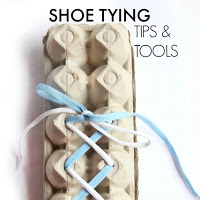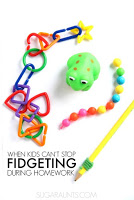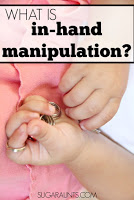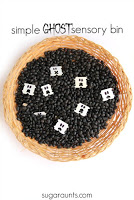Lacing Cards can always be found in an Occupational Therapist’s treatment bag. Every pediatric OT clinic, preschool therapist, and school-based OT has a bag of lacing cards. It’s just that lacing cards are a powerhouse of therapeutic benefits for kids of all ages.
Why use lacing cards with kids of all ages? Read on, I’ve got a great list for you. Today, I’m sharing ideas to make your own homemade lacing cards as well as some of may favorite lacing cards and activities out there on the market.
This post is part of my 31 days of Occupational Therapy series where I’m sharing a month-long OT fest with materials that are mostly free or inexpensive.
Hopefully you can find a few ideas for some areas you are working on in your Occupational Therapy clinic, or your child is building at home, in school, or in homeschool.
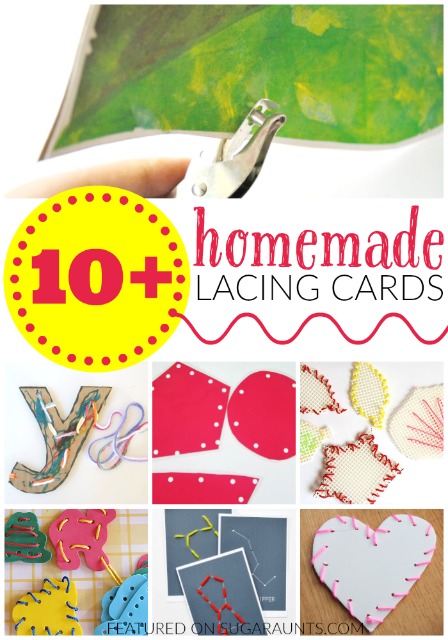
Why should kids use lacing cards for development of skills and learning?
One of my favorite tools that I used with my OT kiddos were lacing cards. You can really modify them to suit the learning objectives and developmental needs of every child. Now, I have a shoebox of lacing cards that I use with my own children in play (and as I sneak in my OT skills with them!). We work on fine motor skill, visual perceptual skills, bilateral coordination, language, literacy, math, tool use, life skills, and more.
How lacing cards are beneficial to kids:
- Development of pincer grasp: Manipulating the string or needle with a pad-to-pad grasp is a fine motor skill children need for many functional tasks. Picking up small items like coins, beads, seeds, etc require a pincer grasp.
- Bilateral Coordination: Children need bilateral hand coordination where they use their dominant hand as a tool user and the non-dominant hand as the assisting hand in skills like handwriting, cutting with scissors, zippering a coat, buttoning a shirt, and drawing. You can see all of our bilateral hand coordination activities here.
- Motor Planning: A motor plan is functional execution of a task which is viewed with the eyes and carried out with the hands in order to complete tasks, such as mazes, walking around obstacles, cutting along a line, and writing within a space on a form. Visual motor skills can be difficult for children with visual processing difficulties. Identifying and organizing information is in a motor plan works on problem solving skills.
- Hand-Eye Coordination: Hand-eye coordination is using the information received through the vision system to coordinate the hands with control, in order to complete a task, such as handwriting or catching a ball. Find more hand eye coordination ideas here.
- Visual Scanning: Children need visual scanning in order to scan a page, read, write, and find a certain colored sock in a drawer full of socks (for example. There are a ton of other ways that visual scanning skills are imperative for functioning in school and home settings.) Find more visual scanning ideas here.
- Literacy: Lacing cards can be modified to meet educational needs of children. Write letters along side the holes and children can practice letter identification, letter recognition, letter sounds, upper and lower case letter matching, alphabetical order, and more.
- Math: Write numbers along the lacing holes and children can work on number identification, number recognition, number order, addition, subtraction, multiplication, skip counting, even/odds, and more. Lacing cards can be created in geometric shapes for shape identification.
- Tool Use: Managing a thread with or without a needle is great practice for tool use in a functional skill.
- Life Skills: Children can be introduced to sewing patterns with thread and a needle.
Kids tend to gravitate towards themes that they love. So a dino fan will maybe try to lace and create with a stegosaurus lacing card. I do love the sturdiness of fabricated lacing cards. They are awesome for little OT hands when you’ve got a crew that uses them day after day.
I’m also going to share some ideas on how to make your own lacing cards. When you make your own, you can customize the fine motor tool to your child’s interests. Get your kiddo in on the creating part, so that they can craft and use their creation.
Related Read: Try these Neat Pincer Grasp Activities to develop fine motor skills.
Homemade Lacing Card Ideas:
- Foam sheets (The Chaos and the Clutter) are very versatile for lacing cards. They can be made into any shape using cookie cutters or free hand drawing like Powerful Mothering did.
- Make a lacing card using recycled materials. We used a take out container. These can be created into any shape you like, too.
- Plastic Mats (Kids Activities Blog) like place mats or sink mats make a nice sturdy lacing card surface.
- A Cardboard Cereal Box makes a great sturdy lacing surface. You can customize it however you like. I love the way Parenting Chaos used a book jacket.
- Cardboard (No Time For Flashcards) created letter shapes.
- Seasons, patterns, and colors can be explored by lacing with wallpaper scraps (Happy Hooligans).
- Cut out shapes from Plastic Canvas, like we did, and practice different types of stitches, as well as math.
- There are, it seems, a limitless supply of free printable lacing cards in any shape or theme out there. These Dinosaur shapes (Living Life and Learning) would be a hit in our house.
- Explore more interests like Outer Space with these Constellation Lacing cards (Kids Activities Blog).
- Use Transparent Office Supplies (Where Imagination Grows) like binder dividers and create a light table lacing activity.
- You can even create a lacing card from Family Photographs (Where Imagination Grows) for a fun lacing activity.
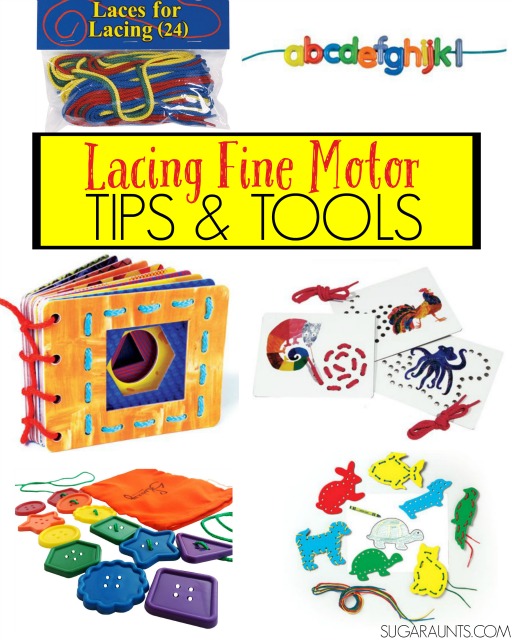
So homemade lacing cards are super cool, and we know WHY kids should be using lacing cards in home, school, and therapy. And we’ve got some fun ideas on HOW to make our own. But what if you just can not get up the oomph to make your own? Here are some of my absolute favorites that are out there.
These are the lacing tools that will work on those fine motor skills, open up the thumb web space, coordinate hand and eye movements, and work two hands together in effortless coordination. Well, maybe it’s not as easy as picking up a card and thread, but lacing cards should have an Occupational Therapy superhero cape on them…
Give this list to grandparents who are asking for gift ideas, put these on your wish list, or just watch for the next sale. Or, if you’re like me, just drool over the awesomeness of the products out there. ((Then go make your own version!))
Who doesn’t love Eric Carle? These The World of Eric Carle Animal Lacing Cardsare gorgeous and bright!
Kids can create a book or hanging wall art with this MoMA Modern Shapes Lacing Cards. What a creative way to work on fine motor skills!
Want to work on lacing cards with the kiddos, but can’t justify the cost? Just grab some colorful Long Extra Laces and make your own using the tips above.
These Letter Beads
are another great way to work on skills that lacing cards do, but while working on literacy too. For added fun, make your own paper plate lacing card and add letter beads within the card to practice letter identification and sounds.
Lacing cards like these Lacing & Tracing Pets
are great for so many skills, but they can be boring for kids after they do them once. Ask kids to lace them together into a garland (tie the strings!), thread in beads, create different patterns, or add literacy/math components. These are cool because you can also use them a stencil and trace them.
I love these Lacing Buttons for their open endedness! Kids can learn shapes, patterns, colors, and sequencing by lacing hem together.
Hopefully, you’ve found some creative ideas here! You might like a few other posts in my 31 Days of OT series:




